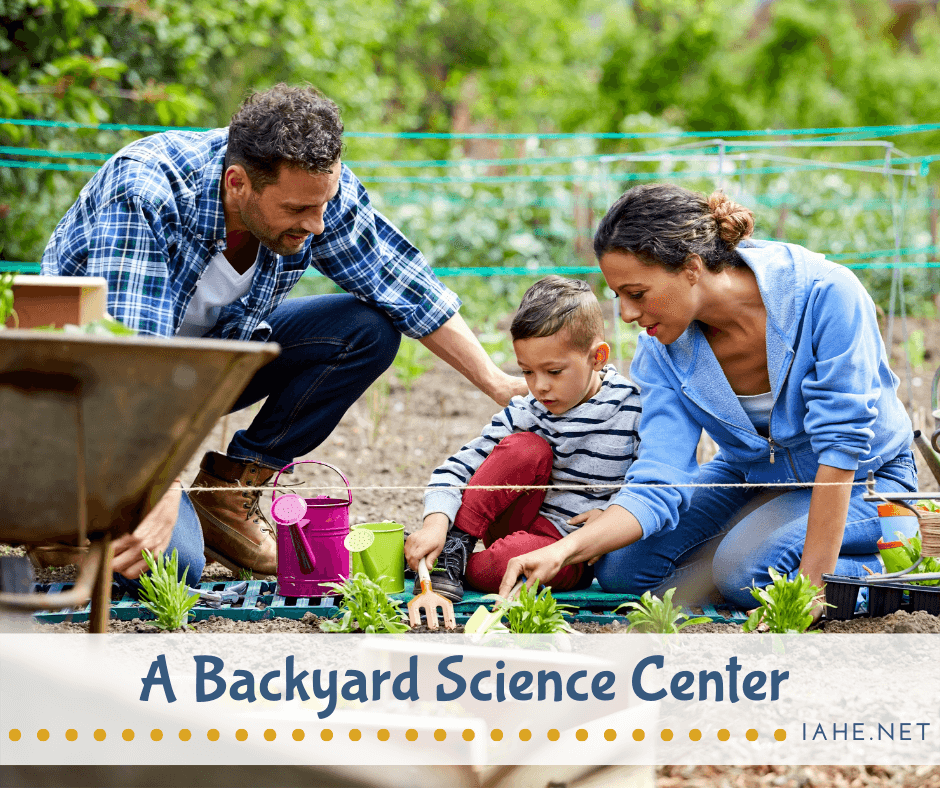
Children are naturally fascinated by nature. How many times has your child pointed out yet another budding tree branch, or showed the “bestest ever dirt-covered rock” (that looks strangely identical to all his other dirt-covered bestest ever rocks)? Making time outdoors, growing things, observing nature, and participating in nature part of your habit early on, will set up a lifetime of joy, wonder, and learning.
Plant a Garden
Children are fascinated by growing things. Flowers, weeds, themselves. Anything that changes and gets bigger, wider, taller, more colorful… they are interested in it! Planting a garden is one of the easiest ways to convert your backyard into a science center.
Gardens can be micro, from a single square foot, to acres. Hanging gardens, windowboxes, and container gardens are great space-savers and perfect for balconies or apartments. Even a flower pot on a sunny windowsill can be a season-long science observation.
Look for fun and lovely native flowers like Blazing Star, Tall Tickweed, Spiderwort, and Pale Purple or Grey Headed Coneflower, which will attract native insects beneficial to your garden. Native plants are often easier to grow than fussy imports.
For vegetables, a single tomato plant will feed your whole family all summer. For kids who love snacking, grow cherry or pear tomatoes and eat them right off the bush. For more variety, add in a simple sweet pepper plant (look for lunchbox peppers for easy snacking) and some warm weather, easy growing herbs like purple basil and chocolate mint. (Plant mint in its own container or it will easily take over your entire garden.).
Buy soil tests and learn pH and acid levels and how to tell the difference. (For reference, Indiana spans three USDA HARDINESS ZONES: 5b in the north, 5a/6b across the center of the state and into the south, and 6a way down by Evansville. Look for plants rated for your area’s zone for the best results.)
New to gardening? Check out Indiana Getting Started Garden Guides: Grow the Best Flowers, Shrubs, Trees, Vines & Groundcovers.
For fruit and veggie gardening, look up Midwest Fruit & Vegetable Gardening.
Hang Birdfeeders
Different birds like different foods, and many are seasonal. In winter, put out songbird food for the eastern bluebirds who overwinter here. Springtime brings finches, thrushes, cardinals, chickadees, juncos, bluebirds, robins, and more.
Some birds prefer branches or sticks to perch on to eat, others are drawn to open plates and flatter surfaces. Offer a variety of perches and foods to draw many types of birds. Hummingbird feeders are pretty, and hummingbird nectar is easy to make at home. And don’t forget a birdbath or other freshwater supply.
Do you have squirrel and bluejay problems? Set up several feeders with safflower seed. This favorite of cardinals, orioles, finches, robins, and other songbirds is a big turn-off to squirrels and jays!
For feeders, consider recycling milk jugs, juice cartons, and 2-litre soda bottles to make hanging feeders. In winter, string popcorn, or hang natural peanut-butter-covered (no sugar added) toilet paper rolls covered in bird seed.
Accomplish two purposes at once—in spring, plant native flowers to attract local songbirds and beneficial pollinators, or cone-shaped flowers like morning glories to attract hummingbirds. You will be brightening up your yard and attracting birds at the same time.
Set Up a Square Foot Area
A Square Foot Area is just what it sounds like—a single square foot marked off in your yard. Observe the myriad of life in this tiny little area. What types of grass or weeds? Any bugs, or evidence of bugs (small holes in dirt, shed exoskeletons, egg pouches, etc).
Dig down a few inches to see what you find. What kind of dirt and rocks and pebbles are present? Observe your square foot over a few seasons or a year. Get a book on rocks and minerals to learn what is in your soil. Found some fossils? Indiana is home to many ancient creatures, including dinosaurs! Check out the Indiana State Museum to see fossils and the Children’s Museum of Indianapolis to see their live paleontology lab!
Observe Weather
Set up a windsock on a pole or garden hook. Look for an open area in your yard away from trees, bushes, or fences that might entangle the wind sock. Paint a stone with the cardinal directions and place it near your windsock to learn wind directions. Keep a compass in the house for indoor observation on those rainy or cold blustery days.
Outdoor patio thermometers are fun to note daily temperatures. Keep a cloud and sky journal to write your observations about the morning, afternoon, and evening. (For non-writing littles, have them dictate to you and you write for them, or have them draw pictures of the clouds.) Learn the “smell” of coming rain or hot weather. If you have a pond nearby, watch the water for signs of wind change, algae growth, and wildlife.
Watch the Wildlife
Even the most open of fields is teeming with wildlife, if we know how to spot it. Start with easy ones like squirrels, chipmunks and birds. Learn to read common animal tracks and check your yard after it rains for any tracks.
Do you have grasses and fields instead of trees? Look for ground-nesting birds, voles, and field mice. In winter, keep a lookout for fox, deer, and rabbit tracks. Check your trees for bird nests, rubbed bark (a sign of deer), or burrows around the roots (mice, voles, and moles.) Practice drawing the animal tracks you see and note where and when you observed them.
Look for chewed bushes and shrubs, clipped flowers, and shorn off fruit plant flowers. Research signs to determine what kind of animals are feasting, and maybe set up a trail or wildlife camera to spot them in action. Discuss why animals snack on garden delights or bushes. In hard winters, look for stripped tree bark where deer will try to find food in the lean months. (Indiana gardens host all kinds of wildlife, from deer and coyotes to foxes, rabbits, squirrels, snakes, and more.)
Can’t tell the difference between a purple finch and a house sparrow? Local field guides are handy resources to keep near your binoculars. (Oh, and did we mention how mind-blowing a feather looks under a field microscope? Just sayin’… you’re welcome.)
Visit Waterways
If you have a pond or stream near your house, make it a priority to visit weekly (or daily, if it’s convenient.) What kind of fish live in your pond? (Note that fishing in ponds may require a state or local fishing license. Check your town for local ordinances.) In spring and fall migrations, what kinds of birds do you observe? Did you know that Indiana is one of the best places to see seasonal bird migrations? Our state sees over 5 million birds and over 300 species migrating to and from Canada each year for nesting and breeding and wintering seasons. Watch the skies in fall for entire flocks of thousands of birds migrating, or look to your ponds regularly for the small groups of waterfowl like buffleheads, lesser scaups, and the elusive green heron. (Make it interactive and submit your findings on eBird.com to the Cornell Lab of Ornithology – also available on the eBird app in both Android and iPhone.)
Check out the shoreline plants and the water plants. A stick dredged gently through a shallow pond edge can yield many types of water plants, laden with frog and fish eggs. Several species of turtles are common in our Indiana ponds, as well as muskrats. Observe herons, Lesser Yellowlegs, Snowy Egrets, and other shore-fishing birds.
How does your pond or stream react to weather? Can you observe water surface changes? Do any animals who like to snack on your garden also like to visit the pond for a drink? Look for tracks and other animal signs.
For older kids, take water samples and examine them under a microscope. What kinds of microscopic organisms, bacteria, and other goodies can you identify?
Listen for sounds of waterlife in the evenings—frogs croaking, fish plopping through the surface at sunset, the soft swish of a muskrat, or the rustle of a pair of ducks in the tall grasses. Listen to the sounds of the breeze rustling through the reeds or blowing through the willows at the edges of a stream. Nature’s music is seldom appreciated for its full beauty.
Gather Some Supplies and Resources
A great back-yard science experience doesn’t cost a lot, just your time. To make your backyard science even better, investing in a few easy-to-find items can bring nature alive even more:
- Quality binoculars. Look for a smaller-sized pair for little hands (but not “Kids” or “toy” binoculars.)
- Nature study kit. It should include a hand magnifying glass, clear specimen cup, tweezers, scoop, sifter, small minnow net, and measuring device.
- Small pocket knife or other cutting tool. Always use proper knife safety and never leave small children alone with knives or other sharp objects. Plastic knives are good substitutes for kids who just have to participate.
- Nature notebook or other way to record your many observations. Consider starting a Calendar of Firsts to record the first changes you notice as seasons pass.
- Field guides and quick references for species identification. An excellent set of sturdy, high-quality, folding guides for Indiana are lightweight for packs. Also consider the excellent Common Backyard Weeds of the Upper Midwest, an amazing resource for learning the names of all that green stuff that grows in between your driveway cracks and chokes out your grass! Good Bug, Bad Bug is a lovely pictorial resource for learning about beneficial and invasive bugs and insects and how to attract/get rid of them.
Ready, Set, Go! You are loaded up with ideas. Have a great summer of backyard science!
